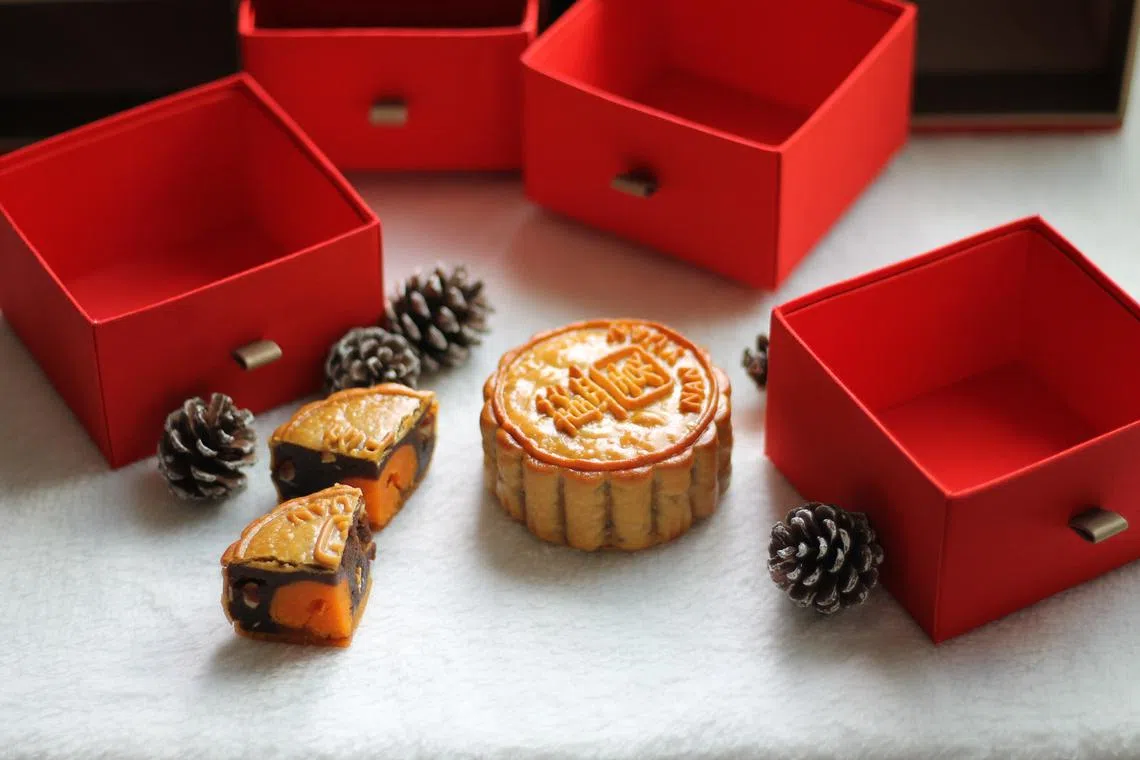Packaging is nice, but taste is key when it comes to buying mooncakes: Survey
Sign up now: Get ST's newsletters delivered to your inbox

Only 28 per cent of the 500 respondents in the survey by Milieu Insight look out for packaging when buying mooncakes.
PHOTO: PEXELS
Follow topic:
SINGAPORE – Taste is still tops when it comes to buying mooncakes, while packaging ranks relatively low.
A recent survey by market research platform Milieu Insight of 500 respondents, conducted from Sept 13 to 18, showed that the top three factors sought when buying mooncakes are taste (82 per cent), price (74 per cent) and flavours (69 per cent). Only 28 per cent look out for packaging when purchasing mooncakes.
This is despite mooncake packaging becoming fancier over the years, from boxes shaped like Chinese pavilions to a container resembling a durian.
Meanwhile, the prices of mooncakes – particularly those from big-name hotels and food establishments – shot skywards in 2023, soaring to an average of $80 to $100 and beyond for four pieces.
Half – or 51 per cent – of respondents in the Milieu Insight survey found extravagant and fancy packages for mooncakes to be expensive and wasteful. In addition, the Milieu Insight survey found that 384 respondents, or 76 per cent, would choose to opt out of such packaging in exchange for a discount, never mind that such an option is rarely offered.
InterContinental Singapore, which offered a 10 per cent discount for mooncakes without its leatherette box in 2023, saw a 25 per cent increase in sales.
For Mr Jenson Kok, 41, receiving mooncakes in fanciful packaging is “pointless”. Said the insurance agent: “I have always looked at the packaging as a means by the seller to justify the exorbitant price tag.”
He added: “Every time I receive a box of mooncakes with fanciful packaging, I would think that I should do something with the nice box. But with numerous boxes sitting at home, it usually ends up discarded. It’s quite a waste, at best I can discard the box as recyclable waste.”
Retailers The Straits Times spoke to, however, defended the use of fancy packaging, saying it is important, especially as mooncakes are often given as gifts.
They also noted that their packaging is environmentally friendly and can be reused.
Some are made to be reused as tealight holders, while others can be used as bedside lamp shades, as storage boxes for accessories like watches, or even as a board game in itself.
WOK°15 Kitchen at One°15 Marina Sentosa Cove, for instance, said its mooncake boxes are designed to be reused as a candle holder, and that the paper packaging is made from sustainable sources.
Ms May Yap, chairman of the Packaging Council of Singapore Industry Group at the Singapore Manufacturing Federation, agreed that there has been a notable rise in the use of sustainable packaging methods and materials in the design of mooncake packaging.
She said: “Many industries, including hotels and bakeries, have been focusing on sustainable packaging. While sustainability is an emerging concern, the packaging for products such as mooncakes, which are often purchased as gifts, needs to be visually appealing.”
There are also practical considerations apart from the presentation elements of the box, said InterContinental Singapore’s director of food and beverage, Mr David Kanna: “We also need to make sure that the packaging can house the mooncakes, is in line with good food hygiene standards, is water- and pest-resistant, and travels well for deliveries.”
Echoing this consideration is casual dining restaurant chain Swensen’s, which sells its ice cream mooncakes in a box made of recyclable kraft paper, adding that the packaging must maintain the product’s quality, keeping it frozen and in optimal condition during transportation to the recipient’s home.
WOK°15 Kitchen said “a discounted price for mooncakes without packaging is not a feasible option” for the Cantonese restaurant, adding that “presenting mooncakes in their packaging is a way to highlight the care and thoughtfulness behind the gift”.
Mr Melvin Lim, general manager of Parkroyal Collection Marina Bay, Singapore, said he has not seen any demand for no-packaging to date, “because most consumers buy mooncakes to be given as gifts, it is important that the mooncakes are presented in high-quality, yet functional packaging”.
Observers say increased environmental awareness has led to more consumers being conscious of the impact of packaging when buying mooncakes.
While sustainable packaging can help minimise environmental impact, WWF-Singapore’s Plastic Action lead Koh Wei Lin highlighted the importance of considering the “waste hierarchy”.
She said “this means focusing on avoiding and reducing before considering reusing and recycling”.
Professor Lawrence Loh, director of the Centre for Governance and Sustainability at NUS Business School, said: “Attractive packaging is steadily and surely waning as an effective marketing tool for mooncakes – often, it may even come across as a gimmick to attract sales.
“In the past, a nice presentation may add to the gift, but this may not be so nowadays, when recipients may prefer things that are environmentally sustainable.”
Disagreeing, Professor Sharon Ng, head of the marketing division at Nanyang Business School at Nanyang Technological University, sees attractive packaging remaining as an effective marketing tool.
“The beautiful packaging resonates with consumers both aesthetically and emotionally. I’ve observed consumers being enticed to purchase mooncakes purely based on appealing packaging.”
Associate Professor Hannah Chang at the Lee Kong Chian School of Business at Singapore Management University noted that consumer demand for sustainable packaging is likely not mainstream yet, with perception of the consumer market segmented.
She said: “The possibility of offering a discount for less packaging can be seen as cost savings or for environmental reasons to different consumers, depending on how businesses communicate the reason for simpler packaging through advertising or other marketing communication channels.”

